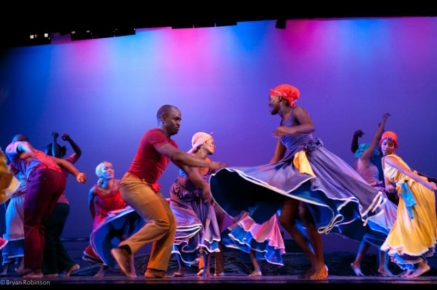The unexpected booming vocals from Busta Rhymes sets the backdrop for the beautiful modern ballet dancers on stage as they perform to Bob Marley’s “Rastaman Chant” featuring the high-energy emcee. It’s a historic moment. The National Dance Theatre Company of Jamaica (NDTCJ) is back on stage in Toronto, Canada for the first time in 15 years.
Songstress Erykah Badu’s vocals also come pouring out from the speaker system on Bob Marley’s “No More Trouble” remix. Dancers move as if punctuated by bullets. They slink across the stage, shoulders back, hips forward, knees bent, leaning into the walk, typical Jamaican bad man fashion. It is all a part of the Urban Fissure opening act. The night’s production is a tribute to late Ralston Milton “Rex” Nettleford, who is a Jamaican scholar, activist, professor and vice chancellor of the University of the West Indies and co-founder of the NDTCJ. The Urban Fissure act vividly displays life in Jamaica’s urban centre of Kingston. Dancers move to an array of changing lights and interview sound bites of Bob Marley. Elements of hip-hop fuse seamlessly into the set.
“People who are not Jamaican can use this show to get a little bit of a sneak peek into what is artistically our eclectic mix.” – Ewan Simpson, NDTCJ Musical Director
Over the last 50 years, the NDTCJ performers have covered international stages to critical acclaim, including several times in Canada. Audience members find beauty and relevance no matter what their background.
“You can see there are more similarities than differences between the cultures,” says audience member Renee Tellis. “I came here with a background in Indian dance and I could see all the elements, it’s so similar to it in the show here. And the music, you come for the music right? You come here to see what’s moving these people.”
“I think it’s very important from that perspective to show a lot of positive aspects of the culture and to show it in a way that is steeped in research and academia as well. Yes it’s raw, from the culture, but it also says something.” – Kerry-Ann Henry, Choreographer
The audience claps and sings in delight and lets out peals of laughter during the Play Time set of traditional folk songs. “There’s a brown girl in the ring tra la la la / Show me your motion tra la la la / she looks like a sugar in a plum plum plum,” the speakers belt. Female dancers dance around wearing plaid tops and yellow skirts, while the men are sporting peasant shirts in green with grey pants. Everyone is bare foot. The display is effective in evoking the Jamaican countryside and times past, but not forgotten.
“People who are not Jamaican can use this show to get a little bit of a sneak peek into what is artistically our eclectic mix,” says Ewan Simpson, the NDTCJ musical director. “As Jamaican people, as Caribbean people, our influences are very many, and this shows how the influences blend to still make the same statement.”
The varying styles of performance have the audience rapt with attention all night, especially a contemporary ballet piece Minutes and Seconds, a duet choreographed by Kerry-Ann Henry and Momo Sanno, which Henry performs with Marlon Simms. They both move across the stage with mirrored movements in complementing teal outfits.
“[What] one audience member said to me is that often the picture of Jamaica is painted in a certain way. She felt very proud because this was a different painting,” shares Henry. “I think it’s very important from that perspective to show a lot of positive aspects of the culture and to show it in a way that is steeped in research and academia as well. Yes it’s raw, from the culture, but it also says something. So for audiences who are not Jamaican, not Caribbean it gives them a sense of, ‘ok, whoa this is different, this is something I would like to find out more about, this is something I didn’t know about these people, this region and it’s something wonderful.’ It’s something really for us to be very proud of, to hold our heads high, to really make a mark. Make our mark.”
Hopefully, the wait for the company’s return to Canadian soil is not another 15 years.
Words By. Rebecca Akrasi-Sarpong




Comments are closed.